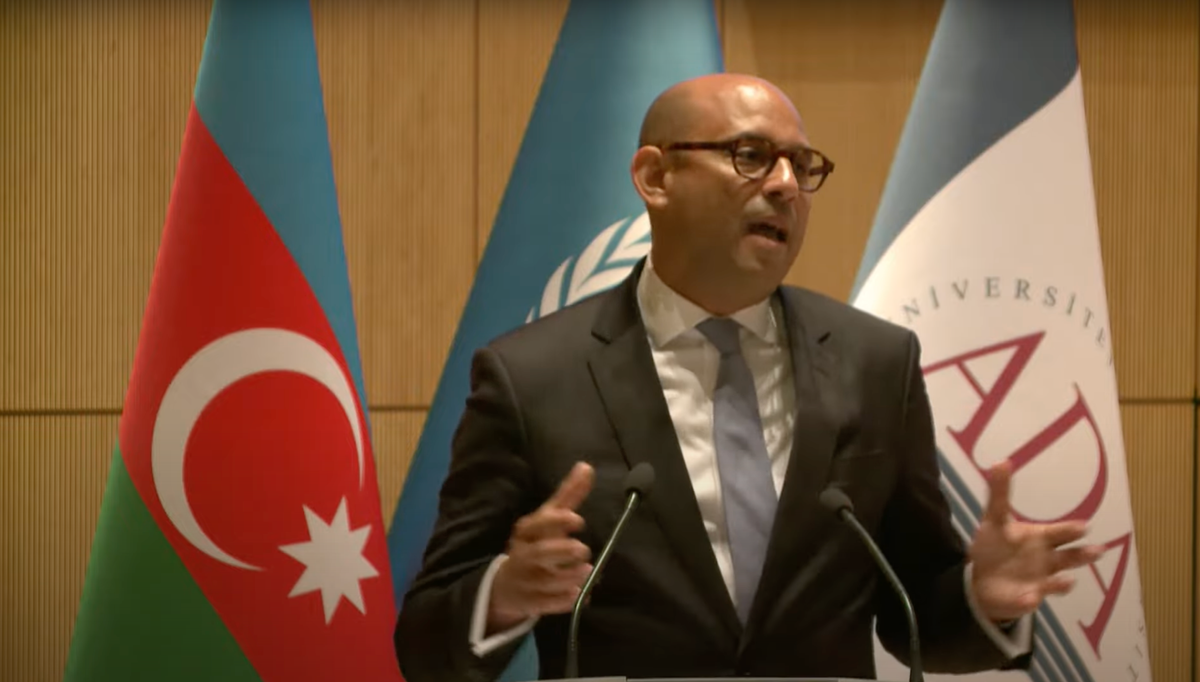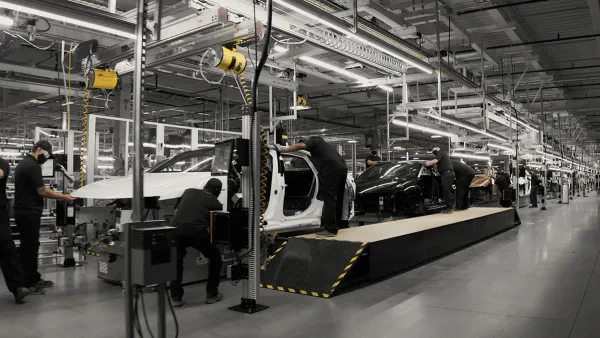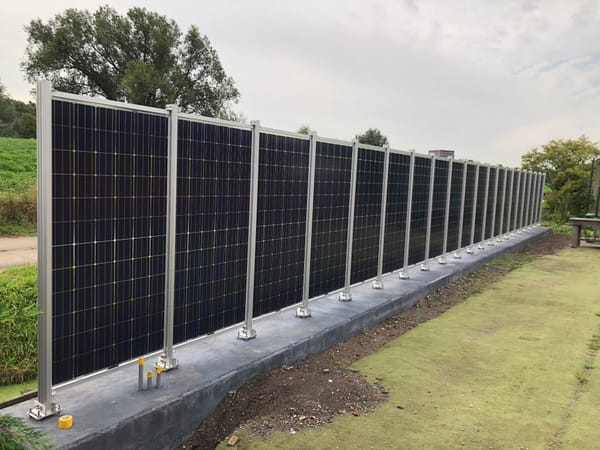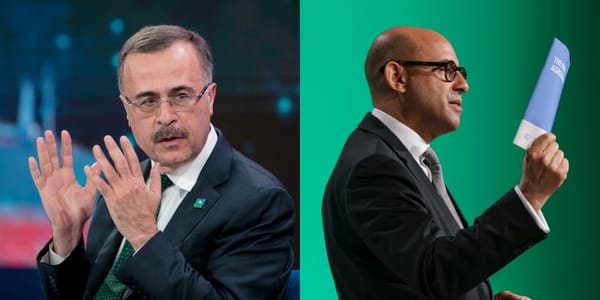Stiell outlines 2024’s difficult climate finance goals

It’s only been seven weeks since COP28 closed in Dubai, but last Friday Simon Stiell, the U.N.’s Climate Change Executive Secretary laid down a marker for what needs to be accomplished at COP29.
“$2.4 trillion..is needed every year to invest in renewable energy, adaptation, and other climate-related issues in developing countries,” he announced in a speech given Friday evening at ADA University in Baku, Azerbaijan, the host city for next November’s global climate negotiations.
As the chief permanent U.N. diplomat for climate issues, Stiell has embraced the job of prodding the world along. Sometimes a nudge. Sometimes a scold.
Climate negotiators left the U.A.E. last year with an agreement that closed up the last major ideological rift on climate: The world’s governments agreed that fossil fuels cause climate change. Along the way, they also promised to continue to finance a host of funds for climate adaptation, loss and damage, rainforest protection, and more. They also promised to triple global renewable energy use by 2030, a laudable goal, but still one that doesn’t get the world to under 1.5°C of warming – to do that we’ll also have to cut carbon emissions by at least 43% and cut methane emissions even more.
Meanwhile, many of the world’s democracies are preparing for a right-ward shift in policy making as elections will sweep the planet, including for the U.S., India, Indonesia, Mexico, the U.K., and the European Parliament. Pakistan kicks off the voting on Thursday, with campaign platforms that have a great deal to say about taking climate change action.
The main topic for COP29 will be, as Stiell made clear, climate finance. Yet, most of that funding will need to come from the U.S. and Europe. The E.U. elections are in early June, U.K.’s are expected to be scheduled for late 2024, and the American elections will be November 5. That leaves little time for leaders to decide how much financial assistance they’ll be willing to commit to climate. And, if the U.S. and E.U. elections shift their governments rightward, we should expect significantly less financial assistance for climate.
Even so, the decisions to be made in the margins will still have big impacts. For instance, the $100 billion Loss & Damage Fund committee will meet in March to decide how to operationalize distributing the funds. Who gets that money and how it could be used also needs to be decided.
Later this month the Article 6.4 Supervisory Body will meet in Bonn to take a fourth crack at developing international carbon credit trading rules that could pass at COP29. The rules have repeatedly failed to be adopted due to existential differences of vision between Europeans and Americans. But perhaps the ongoing collapse of voluntary carbon credit markets – and the threat that poses to the safety of the world’s rainforests – will spur negotiators on to an agreement.
And count me as one of the people who think that the huge attendance from COP28’s “climate industry circus” was a good thing. While curmudgeonly negotiators and observers may not have liked all the slick business people hanging around, those tens of thousands of extra attendees brought new attention and commercial energy to the climate problem. If we’re going to solve climate, all those business people can bring the commerce we need – as much as $9 trillion of green commerce a year according to one McKinsey study.
As is becoming very clear, it’s going to take more than just a will to change. Global leaders and climate negotiators need to address the political and financial problems holding us back.
For instance, Saudi Arabia and other petrostates rely on oil and gas revenues for internal political stability. What are the realistic alternatives for them?
Developing nations like India, Bolivia, and others need to grow their economies to lift their populations out of poverty, and fossil fuels are much cheaper than green energy. What will it take to get them to go green?
The United States is obsessed with global competition and won’t take any climate steps unless other major emitters do the same thing. What are the circumstances for an agreement where Europe, India, the U.S. and China all take equal responsibility?
Stiell laid down his marker. “We need torrents, not trickles of climate finance,” he said. Even so, it’s going to take addressing some core political issues before we can move forward.
We’ve got 40 weeks to see what climate politics can get done.
After a brief hiatus following COP29, this newsletter is taking on an absurdly ambitious idea: To report on the politics of climate change in all of its dimensions. I’m going to dig into the decision-making of the biggest emitters – Europe, China, the U.S., and India. But also the numerous other important players that change the world, like the OPEC countries, the increasingly coordinated G77 coalition of developing countries, and nations like Brazil, Russia, and South Africa, whose own development needs also need to be addressed.
This year there are major political changes on the horizon, each of which will have major implications on how the climate crisis is addressed, for instance:
- The threat of Trump withdrawing the United States from the Paris Agreement.
- The World Bank’s attempt to syndicate investment into green energy projects.
- Setting new development bank loan terms for developing nations.
- The political rise of countries with valuable mineral deposits.
- The struggle over implementing the Loss & Damage Fund.
- Finally determining rules for carbon credit trading – who’s economies will they benefit?
I have a plan to address these issues, but it’s going to take some time to work up to it. For now, I’m going to start with two newsletters a week, on Tuesday and Friday. Tuesday will contain a wrap up of the climate politics news of the week, and in a couple Fridays I’ll start to produce deep dives on specific issues or questions, like the bullet points above.
I’m also going to aim to produce and post a short video on YouTube every two weeks. You can watch the first one here. My report last month found a drought of non-advocacy information on climate, and a recent Pew poll found over half of Americans get their news from social media. This is my effort to go where the audience lives.
I have some big plans in the works for Heat Rising. Please drop me a note if you have any thoughts or recommendations by just responding to this email.
Like what you see here? Please forward this to friends.
The First Heat Rising Video!
Every couple of weeks I'll produce and post a new YouTube video. Please watch and let me know what you think!
Climate News of Note
Feb. 1
India to increase coal-fired capacity in 2024 by the most in at least 6 years [Reuters]
Rich nations miss loss and damage fund deadline [Climate Home News] – EU and Umbrella Group nations haven’t appointed their board members and are tussling over the number of seats each gets.
Exclusive: World Bank to offer countries access to emergency funds from existing loans [Reuters]
Jan. 31
Biden Picks John Podesta to Be His New Global Climate Representative [New York Times]
China's wind, solar capacity set to outshine coal in 2024 [Times of India]
‘Hypocritical’ European politicians weaken climate policies amid farmer protests [Guardian]
Jan. 30
For COP29 to succeed, rich nations must get their parliaments to agree more finance now [Climate Home News] – Editorial from Evans Njewa, chair of the Least Developed Countries group.
Global Clean Energy Spending Surges to $1.8 Trillion. It’s Not Enough [Bloomberg]
China's wind, solar capacity forecast to overtake coal in 2024 [Reuters]
Jan. 29
Climate change figures prominently in Pakistan political parties' manifestos [Times of India]
Jan. 26
Climate threatened Tuvalu holds election watched by Taiwan, China [Reuters]





